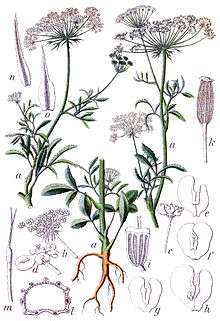Ammi majus
Ammi majus, commonly called bishop's weed,[2] false bishop's weed,[2] bullwort,[2] greater ammi,[2] lady's lace,[2] false Queen Anne's lace,[3] or laceflower, is a member of the carrot family Apiaceae. The plant, which has white lace-like flower clusters, is native to the Nile River Valley.
| Ammi majus | |
|---|---|
 | |
| Scientific classification | |
| Kingdom: | Plantae |
| Clade: | Tracheophytes |
| Clade: | Angiosperms |
| Clade: | Eudicots |
| Clade: | Asterids |
| Order: | Apiales |
| Family: | Apiaceae |
| Genus: | Ammi |
| Species: | A. majus |
| Binomial name | |
| Ammi majus | |
| Synonyms[1] | |
| |
Uses
In Egypt around 2000 B.C., the juice of Ammi majus was rubbed on patches of vitiligo after which patients were encouraged to lie in the sun.[4] In the 13th century, vitiligo was treated with a tincture of honey and the powdered seeds of a plant called "aatrillal," which was abundant in the Nile River Valley. The plant has since been identified as A. majus[5] but the trade name Aatrillal is still used today to refer to the yellowish-brown powder made from its seeds.
Ammi majus contains significant amounts of both bergapten and xanthotoxin (also known as methoxsalen), two psoralen derivatives well known for their photosensitizing effects. Indeed, A. majus may well be the world's major source of methoxsalen.[4]
The practice of using Ammi majus to treat vitiligo implicitly acknowledges the hyperpigmentation effects caused by exposure to a photosensitizing agent (such as methoxsalen) followed by ultraviolet radiation. An excess of either the photosensitizing agent or subsequent UV exposure can lead to phytophotodermatitis,[4][6] a serious skin inflammation. Despite this danger, A. majus is cultivated for its furanocoumarins, which are still used for the treatment of skin disease.[7]
Cultivation
Like its close relative Ammi visnaga, A. majus and its cultivars are frequently seen in gardens where they are grown from seed annually. The species[8] and the cultivar 'Graceland'[9] have both gained the Royal Horticultural Society's Award of Garden Merit.
References
- The Plant List: A Working List of All Plant Species, retrieved 20 December 2015
- "Ammi majus". Germplasm Resources Information Network (GRIN). Agricultural Research Service (ARS), United States Department of Agriculture (USDA). Retrieved 8 January 2018.
- "Flowers in Israel".
- McGovern, Thomas W; Barkley, Theodore M (2000). "Botanical Dermatology". The Electronic Textbook of Dermatology. Internet Dermatology Society. Section Phytophotodermatitis. Retrieved October 7, 2018.
- Wyss, P. (2000). "History of Photomedicine". In Wyss, P.; Tadir, Y.; Tromberg, B. J.; Haller, U. (eds.). Photomedicine in Gynecology and Reproduction. Basel: Karger. pp. 4–11.
- Alouani, I.; Fihmi, N.; Zizi, N.; Dikhaye, S. (2018). "Phytophotodermatitis following the use of Ammi Majus Linn (Bishop's weed) for vitiligo" (PDF). Our Dermatol. Online. 9 (1): 93–94. doi:10.7241/ourd.20181.29.
- "Plants For A Future: Ammi majus".
- "RHS Plantfinder – Ammi majus". Royal Horticultural Society. 2017. Retrieved 12 January 2018.
- "RHS Plantfinder – Ammi majus 'Graceland'". Royal Horticultural Society. 2017. Retrieved 5 January 2018.
External links
- She Menglan and Mark F. Watson (2005), "Ammi majus Linnaeus, Sp. Pl. 1: 243. 1753", Flora of China Online, 14
.jpg)
.jpg)
